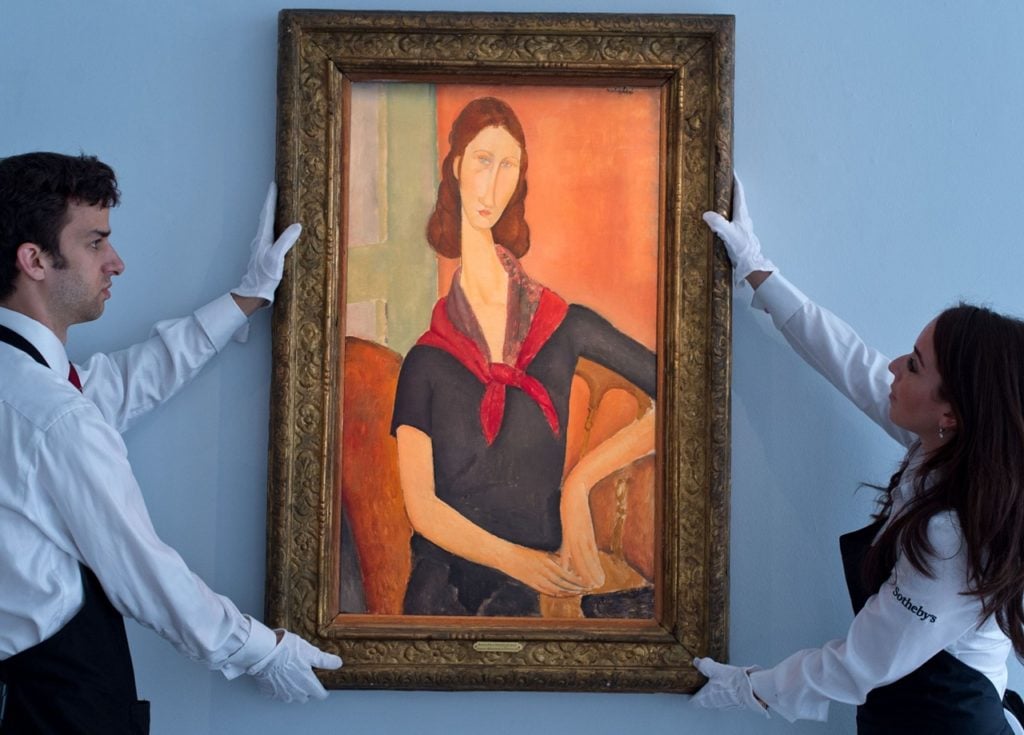Art World
Art Demystified: Why is Buying Art as an Investment Frowned Upon?
Let's talk about the money.

Using art as a means to make money or transfer assets isn’t
new, but “investment” is almost a dirty word when used in the context of
the art world. Why is it so frowned upon? Everybody working in the art
market has to make a living, after all.
From an economic standpoint, galleries and artists dislike the concept of “flipping” art—buying art with the explicit intention to resell—because a high number of works on the market can undermine an artist’s value. It’s about supply and demand, since scarcity creates high prices.
Related: Art Demystified: What Determines an Artwork’s Value?
“I think artists are uncomfortable about, and do not wish to have their work discussed in terms of prices and market value, and what is selling and not selling,” art dealer Augusto Arbizo, director and partner at New York’s 11R gallery, told artnet News in an e-mail. “They want the work discussed in critical terms and historical context.”
However, according to the outspoken Los Angeles dealer and collector Stefan Simchowitz, the reality is quite different. “99 percent of people who buy a piece of art do so because they believe it will have more value in the future, and if it doesn’t then somehow the quality of the art in their minds is reduced,” he told artnet News in a telephone interview.
 “So what you have is an entire industry of collectors and supporters
who pretend, and have spent an enormous amount of time constructing a
false narrative to explain that they collect art because they love
it and that it has nothing to do with money,” he continued. “But
somewhere in the conversation it’s always about money. It’s one of these
mythic, moral hypocrisies that’s been built within the culture system.”
“So what you have is an entire industry of collectors and supporters
who pretend, and have spent an enormous amount of time constructing a
false narrative to explain that they collect art because they love
it and that it has nothing to do with money,” he continued. “But
somewhere in the conversation it’s always about money. It’s one of these
mythic, moral hypocrisies that’s been built within the culture system.”
Related: Art Demystified: How to Authenticate a Contemporary Artwork
Indeed, there is mounting evidence of increased speculation in the contemporary art market. Artists whose work comes up at auction are increasingly younger, as investors seek to capitalize on the next star artist by purchasing their work early. The flipside is that a sharp increase in price is often followed by a rapid descent, as the rise and fall of the so-called “zombie formalists” painters demonstrated.
Simchowitz says he advocates a frank approach to buying and selling art. He himself specializes in purchasing large quantities of art directly from emerging artists, often with the intention to resell. However, unlike virtually any other collector or dealer, he does so openly.
“Now if an honest art world is better or worse than a dishonest art world I don’t know,” he conceded. “I just think that clarity and transparency is going to be much more effective for a heterogeneous form of cultural production and distribution instead of this homogenized, fake moral mythology that has led people to collect the same things, in the same way, over and over again, masking their intentionality in some kind of falsehood.”
Follow artnet News on Facebook.
From an economic standpoint, galleries and artists dislike the concept of “flipping” art—buying art with the explicit intention to resell—because a high number of works on the market can undermine an artist’s value. It’s about supply and demand, since scarcity creates high prices.
Related: Art Demystified: What Determines an Artwork’s Value?
“I think artists are uncomfortable about, and do not wish to have their work discussed in terms of prices and market value, and what is selling and not selling,” art dealer Augusto Arbizo, director and partner at New York’s 11R gallery, told artnet News in an e-mail. “They want the work discussed in critical terms and historical context.”
However, according to the outspoken Los Angeles dealer and collector Stefan Simchowitz, the reality is quite different. “99 percent of people who buy a piece of art do so because they believe it will have more value in the future, and if it doesn’t then somehow the quality of the art in their minds is reduced,” he told artnet News in a telephone interview.

Stefan Simchowitz wants to talk openly about the money. Photo: Angela Weiss/Getty Images for Art Los Angeles Contemporary.
Related: Art Demystified: How to Authenticate a Contemporary Artwork
Indeed, there is mounting evidence of increased speculation in the contemporary art market. Artists whose work comes up at auction are increasingly younger, as investors seek to capitalize on the next star artist by purchasing their work early. The flipside is that a sharp increase in price is often followed by a rapid descent, as the rise and fall of the so-called “zombie formalists” painters demonstrated.
Simchowitz says he advocates a frank approach to buying and selling art. He himself specializes in purchasing large quantities of art directly from emerging artists, often with the intention to resell. However, unlike virtually any other collector or dealer, he does so openly.
“Now if an honest art world is better or worse than a dishonest art world I don’t know,” he conceded. “I just think that clarity and transparency is going to be much more effective for a heterogeneous form of cultural production and distribution instead of this homogenized, fake moral mythology that has led people to collect the same things, in the same way, over and over again, masking their intentionality in some kind of falsehood.”
Follow artnet News on Facebook.
Share


No comments:
Post a Comment